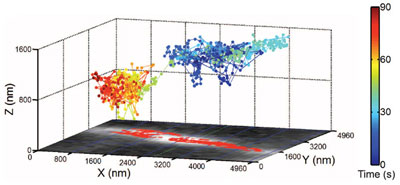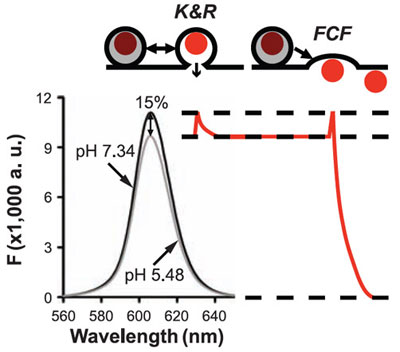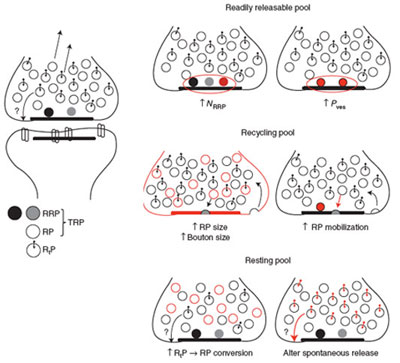
Synaptic Vesicle Dynamics & Modes of Fusion
Neurons send signals when a synaptic vesicle containing a transmitter substance forms a connection with the extraneuronal space and the neurotransmitter is released. There is complete agreement that synaptic vesicles can undergo cycling by the pathway classically described by Heuser and Reese, wherein a full collapse fusion event mediates neurotransmission, and the fully flattened vesicular membrane and perhaps some of its original constituents are retrieved by clathrin-mediated endocytosis.
In the Tsien Lab we focus mainly on an alternative recycling pathway, called kiss-and-run, in which the vesicle releases transmitter through a fusion pore that closes before flattening can occur. Although highly controversial, this alternative mode of fusion offers the possibility of greater efficiency (the retrieved vesicle retains enough components to become ready for reuse within seconds, without need for complete rebuilding) and perhaps a different kind of synaptic signaling that has analog as well as digital features.
Related Publications
Park H … Tsien RW. Influence of synaptic vesicle position on release probability and exocytotic fusion mode. Science. 2012. DOI.

Using three-dimensional, real-time tracking of quantum dot-loaded single synaptic vesicles, we are able to determine the time, position, and mode of fusion using Qdot fluorescence and trypan blue quenching. We find that the mode of fusion, either kiss-and-run or full-collapse, depends on the prior motion of the vesicles.
Zhang Q … Tsien RW. The dynamic control of kiss-and-run and vesicular reuse probed with single nanoparticles and exocytotic fusion mode. Science. 2009. DOI.

We developed an approach for loading individual synaptic vesicles with single quantum dots. Using both their size and pH-dependent photoluminescence changes, we could distinguish kiss-and-run and full-collapse fusion events. We found that kiss-and-run occurred at the beginning of stimulus trains, reflecting a preference for vesicles with high release probability.
Alabi AA and Tsien RW. Synaptic vesicle pools and dynamics. Cold Spring Harb Perspect Biol. 2012. DOI.

Synaptic vesicles release neurotransmitter at chemical synapses through a dynamic cycle of fusion and retrieval. Evidence indicates that vesicles differ in their release availability and their mobility, prompting classification into three functionally different pools. We discuss current perspectives on these pools, how they shape synaptic transmission, and questions for future research.